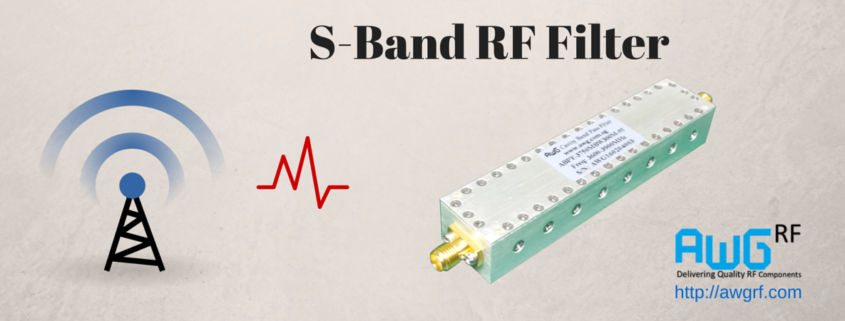S-Band RF Filters : The Crucial Functions
S-Band RF Filter can be found in many S-band receivers.
In the complex, yet interesting, realm of communications, “RF filters” play a very major role. RF, or radio frequency filters are designed and manufactured to operate on signals in medium to extremely high frequencies, which are used for TV, radio and wireless communication. But to ensure that the signals received are clear, and not muddled, some kind of filtering or separating is done (hence the world “filter”), in order to combine or separate multiple frequency bands, like the S-band. Let’s discuss the technical aspects, and benefits, of S-band RF filters.
What Exactly Is The S-Band?
Here’s why S-Band RF filters are valuable items – of the different bands in the standard radar frequency letter band, the “S-band” is perhaps one of the most commercially profitable, because it’s the realm where the world’s top mobile broadband services operate.
The frequency is known as the 2.5 GHz band, and is used globally for providing crucial (and truly profitable) mobile broadband services, through the use of technologies like WiMAX and LTE (Long Term Evolution).
The S-band is also considered as a very unique one, because according to communications experts, it contains a substantial amount of spectrum (190 MHz), which can be put to valuable use for mobile services. All the other spectrum bands up to 3.5 GHz have significantly smaller amounts allocated for terrestrial mobile communication, while others have allocated none at all.
What Are The Main Functions Of S-Band RF Filters?
In the highly valuable, and truly busy S-band, S-band filters perform very crucial tasks. For starters, they allow, or stop, selected signals or frequencies, and are used to filter out or remove any unwanted signals.
S-band RF filters are also designed to allow for the “attenuation” or transmission of an array of frequencies that would be applied. For example, the filter helps cut out or remove any RF interference that may occur if a lamp, hair dryer or cable television receiver is activated within the neighborhood or vicinity.
What to consider when choosing an S-Band RF Filter?
When choosing S-band RF filters (or just about any type of filter), there are a couple of parameters to consider. For starters, the user should take into account the RF filter’s package type, and determine if they require hole mount, surface mount and other types.
The next aspect to consider (or take into account) would be insertion loss, which refers to the signal strength at the output of the filter divided by the input signal power, as well as the filter’s specified frequency.
The RF filter’s voltage standing ratio (or the quantity or “reflected” energy), as well as the “ripple”, or peak to peak difference of the filter response, should also be carefully considered by the customer.
Today, various types of filters, including S-band RF filters of course, can be found in various applications, and among these include air traffic control and communications systems, satellite communications, telemetry, fire control radars, radar and missile guidance systems, and even keyless door locks!
Get a custom S-Band RF Filter for your project
Even though AWG Tech produces many S-Band RF filters, it may not be possible to find out that fits all your requirements exactly. In this case, why not consider getting a custom made S-Band Filter for your system. There is no extra cost and you’ll get a filter that meets your exact requirement.
So go ahead and send us an enquiry here.
Contact Us Today
1 Coleman Street #10-06
The Adelphi Singapore 179803
CO Reg: 201204264E
Phone: +65 8408 8454 Fax: +65 6333 0635
http://awgrf.com
Pages
- 1 To 18GHz Power Divider
- 1-6GHz 4W Power Amplifier
- 10 dB Directional Coupler
- 2-way Power Divider
- 20 dB directional coupler
- 3 Port Directional Coupler
- 3-way Power Divider
- 30dB Directional Coupler
- 4 Port Directional Coupler
- 4-way power divider
- 450MHz Band Pass Filter
- 546 MHz Band Pass Filter
- 6 – 18 GHz Power Divider
- 6 way power divider
- 8 way power divider
- About Us
- Band Pass Filter
- Band Pass Filter for UHF Transmitter
- Band Stop Filter
- Bi-directional Coupler
- Blog
- C Band Interference Elimination Filter
- C-Band Bandpass Filter
- C-Band Bandstop filter
- C-Band Cavity Filter
- C-Band Directional Coupler
- C-Band High Pass Filter
- C-Band Low Pass Filter
- C-Band Power Divider
- Cavity Filter Manufacturer
- Contact
- Directional Coupler 5-1000 MHz
- Directional Couplers
- FM-Band Bandpass Filter
- FM-Band High Pass Filter
- Front End Preselector
- GSM Cavity Filter
- HF Preselector
- HF-Band Band Pass Filter
- HF-Band Bandstop filter
- HF-Band High Pass Filter
- HF-Band LC Filter
- HF-Band LC Low Pass Filter
- HF-Band Low Pass Filter
- High Pass Filter
- Hybrid Coupler
- Ku Band Low Pass Filter
- Ku-Band Band Pass Filter
- Ku-Band Cavity Filter
- Ku-Band Directional Coupler
- Ku-Band High Pass Filter
- Ku-Band Power Divider
- L-Band Bandpass Filter
- L-Band Bandstop Filter
- L-Band Cavity Filter
- L-Band Directional Coupler
- L-Band High Pass Filter
- L-Band Low Pass Filter
- L-Band Power Divider
- Low Pass Filter
- Low Pass Filter for UHF Transmitter
- Power Divider
- Pre-selector for SDR
- Pre-selector Switched Filter Bank
- Products
- RF Component Company
- RF Low Noise Amplifier
- RF Pre-selector
- S-Band Bandpass Filter
- S-Band Bandstop Filter
- S-Band Cavity Filter
- S-Band Directional Coupler
- S-Band High Pass Filter
- S-Band Low Pass Filter
- S-Band Power Divider
- Suspended Stripline Filter
- UHF Band Low Pass Filter
- UHF Band Pass Filter
- UHF Preselector
- UHF-Band Bandstop Filter
- UHF-Band High Pass Filter
- UHF-Band LC Filter
- VHF Band LC Low Pass Filter
- VHF Pre-selector
- VHF-Band Band Pass Filter
- VHF-Band High Pass Filter
- VHF-Band LC Bandpass Filter
- VHF-Band Low Pass Filter
- Wideband Coupler
- Wideband Power Divider
- Wideband Preselectors
- X Band Low Pass Filter
- X-Band Bandpass Filter
- X-Band Cavity Filter
- X-Band Directional Coupler
- X-Band High Pass Filter
- X-Band Power Divider

